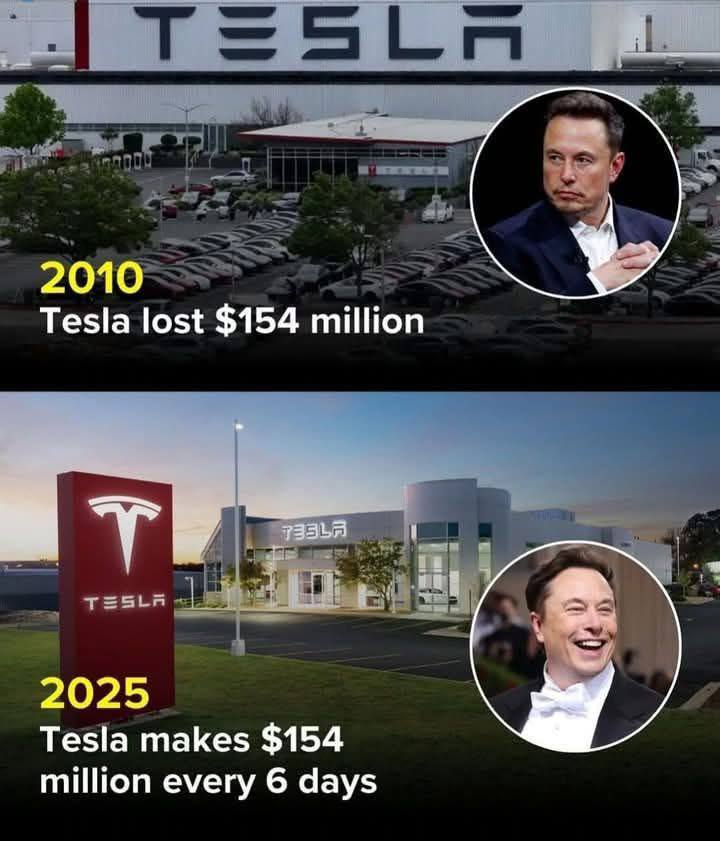In 2010, Tesla was on the verge of collapse. A young, ambitious Elon Musk faced sleepless nights, watching his dream of revolutionizing the auto industry hang by a thread. That year, the company had reported a staggering loss of $154 million—critics mocked, investors hesitated, and competitors dismissed Tesla as a fleeting experiment. The road ahead seemed impossible.
But Musk refused to give up. Instead, he poured every ounce of his energy, passion, and risk-taking into keeping Tesla alive. Factories were built, technology improved, and skeptics gradually turned into believers.
Fast forward to 2025, and Tesla’s reality is almost unrecognizable. That same $154 million the company once lost in a year? Now, Tesla earns it every six days. Tesla’s showrooms shine under the evening sky, the company’s logo glowing like a beacon of innovation. And Elon Musk? No longer the worried entrepreneur fighting for survival—now, he’s the billionaire who proved the world wrong.
How did Tesla achieve such a dramatic turnaround? Was it sheer genius, relentless perseverance, or a mix of both? This is the story of one of the greatest business transformations of our time.

The Struggles of Tesla’s Early Years
Tesla was founded in 2003 by engineers Martin Eberhard and Marc Tarpenning, but it was Musk’s vision and investment that truly shaped the company. By the late 2000s, Tesla had developed the Roadster, an electric sports car that generated buzz but struggled with high production costs and delays.
The biggest challenge? Funding. Building a car company from scratch is one of the most expensive ventures in the world. Musk personally invested over $70 million from his PayPal earnings to keep Tesla afloat. But even that wasn’t enough.
By 2008, Tesla was nearly bankrupt. The global financial crisis had dried up investment opportunities, and Tesla was bleeding money. Musk had a choice: let Tesla die or put everything on the line. He chose the latter, personally borrowing money to pay employees and securing last-minute funding to keep the company alive.
The Turning Point: Model S and Gigafactories
Tesla’s first major breakthrough came in 2012 with the launch of the Model S, a luxury electric sedan that combined long-range capability with cutting-edge technology. Unlike other electric vehicles at the time, the Model S proved that EVs could be both practical and exciting.
Key Innovations in the Model S:
- Extended Range: Up to 265 miles per charge (a game-changer for EVs at the time).
- Supercharger Network: Tesla began developing a fast-charging network across the U.S. to address “range anxiety.”
- Over-the-Air Updates: Tesla introduced software updates that improved vehicle performance remotely.
The Model S was a huge success, winning numerous Car of the Year awards and positioning Tesla as a serious contender in the auto industry. However, success also brought new challenges: scaling production.
This led to the creation of Gigafactories—massive facilities designed to produce batteries and vehicles at an unprecedented scale. The first Gigafactory opened in Nevada in 2016, drastically lowering production costs and increasing Tesla’s manufacturing efficiency.
Expanding the Lineup: Model 3, Model X, and Model Y
While the Model S proved that electric cars could be luxurious and high-performance, Tesla needed an affordable EV to truly revolutionize the market. Enter the Model 3 in 2017.
Why the Model 3 was a Game Changer:
- Starting price of $35,000, making it accessible to the mass market.
- Over 500,000 pre-orders, showing massive demand before production even began.
- Autopilot and self-driving technology introduced, setting Tesla apart from competitors.
At the same time, Tesla expanded its lineup with the Model X (SUV) and Model Y (compact SUV), catering to different customer preferences. Despite production challenges and delivery delays, the Model 3 and Model Y became the best-selling EVs in the world.
Profitability and Billion-Dollar Success
By 2020, Tesla was no longer just a struggling startup—it had become a financial powerhouse.
- Tesla turned a profit for the first time in 2020, proving that EVs could be a sustainable business model.
- Stock prices skyrocketed, making Tesla one of the most valuable companies in the world.
- Battery technology improved, increasing range while reducing costs.
- Autonomous driving advancements positioned Tesla as a leader in AI-driven transportation.
By 2025, Tesla had reached a point where it earned the same $154 million it lost in 2010 every six days.
The Future of Tesla: Beyond Cars
While Tesla’s success in the auto industry is remarkable, Musk has always had bigger ambitions. Tesla has expanded into several other industries:
1. Energy Sector
- Tesla’s Solar Roof and Powerwall allow homeowners to generate and store renewable energy.
- Large-scale battery projects help power entire cities, reducing reliance on fossil fuels.
2. AI and Self-Driving Cars
- Tesla’s Full Self-Driving (FSD) technology aims to create a future where cars drive themselves.
- Robo-taxis could revolutionize ride-sharing and urban transportation.
3. SpaceX and Mars Colonization
- While not directly related to Tesla, Musk’s vision for interplanetary travel through SpaceX aligns with his goal of advancing humanity.
Conclusion: A Legacy of Innovation
Tesla’s journey from near bankruptcy to one of the most valuable companies in the world is nothing short of legendary. Elon Musk’s unwavering belief, willingness to take risks, and relentless pursuit of innovation turned Tesla into a global leader in sustainable technology.
As of 2025, Tesla continues to push boundaries—not just in cars, but in energy, artificial intelligence, and even space exploration. The company’s impact on the world is undeniable, and the story isn’t over yet.
From losing millions to earning billions, Tesla’s impossible comeback serves as a powerful reminder that with vision, resilience, and bold innovation, anything is possible.


